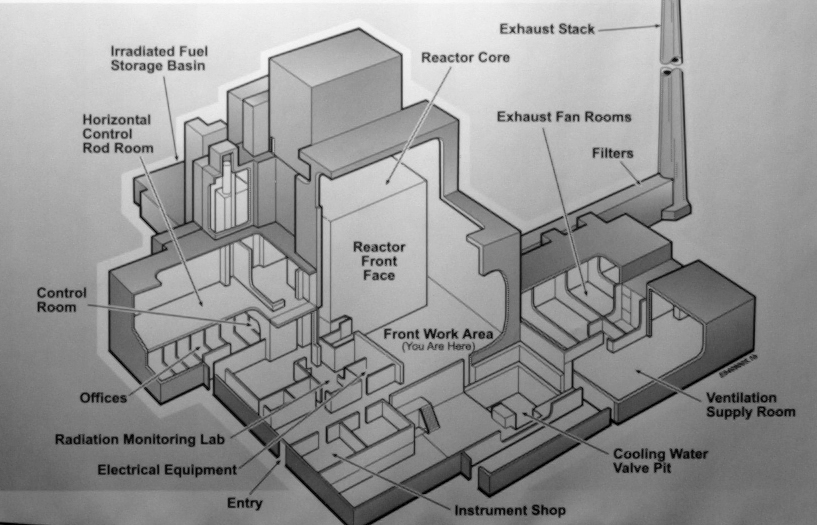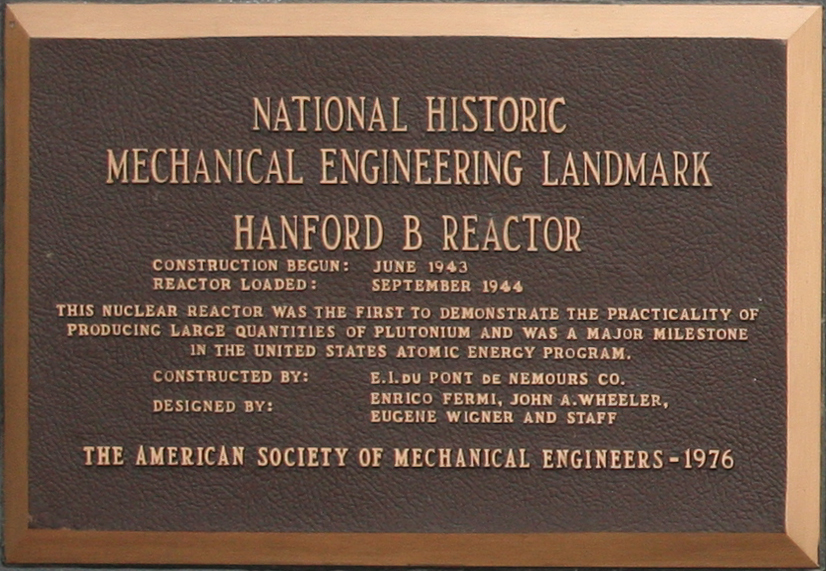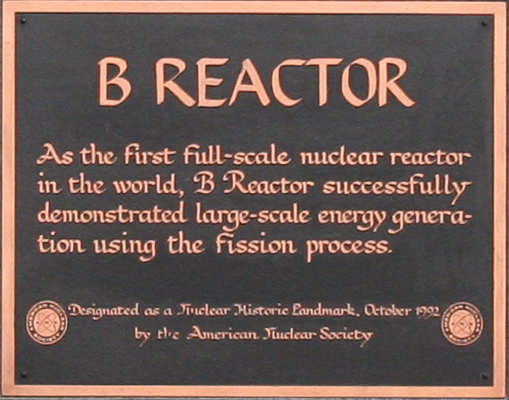The B Reactor is the sort of crown jewel of a Hanford Site tour. It is one of only a select few reactors that is open to the public. The reactor was built in 1943, specifically to produce plutonium for use in atom bombs. At the time of its construction, the scientists were not certain exactly how much of the new material would be required. So one of the jobs of the B reactor would be to make plutonium for experimental use, allowing the scientists and engineers to determine its critical mass (which they did not know at the time **See Footnotes), and decide how it might be used, and how much would be required.
 The B reactor, as built, was 250 times more
powerful than the previous X-10 reactor working at Oak Ridge. It was able to
transmute 250 grams of plutonium a day, from uranium fuel rods. It was a
graphite reactor, which has the advantage of not requiring enriched uranium to
work. Normal metallic uranium can be used, which was just as well. There were
only laboratory amounts of pure U235 in existence at the time - nothing like the
production amounts which would have been required for enriched operation. The
amount of U235 in natural uranium is 0.7%.
The B reactor, as built, was 250 times more
powerful than the previous X-10 reactor working at Oak Ridge. It was able to
transmute 250 grams of plutonium a day, from uranium fuel rods. It was a
graphite reactor, which has the advantage of not requiring enriched uranium to
work. Normal metallic uranium can be used, which was just as well. There were
only laboratory amounts of pure U235 in existence at the time - nothing like the
production amounts which would have been required for enriched operation. The
amount of U235 in natural uranium is 0.7%.
The reactor initially produced 250 MW of power, though no electricity was ever generated. It was eventually tweaked to an output of 2GW. So at the end, it was producing 2 KG of plutonium a day. In ten days, enough plutonium could be produced to make a sphere of critical mass. Newer bomb designs required only half of this amount, or less, through explosive compression of the pit. So every three to five days, one bomb worth of material could be produced. The working design had 2004 loading channels or tubes. Each tube held 32 slugs of uranium. Each slug was eight inches long, by about an inch and a half in diameter. When being loaded, the uranium was preceded by 16 dummy slugs, of aluminum, and followed by 16 more dummy slugs. This was to fill the shielding spaces, and make certain that all uranium slugs were accurately positioned in the graphite core.
Still, with all of this, the B reactor doesn't look like much, when being approached. The photograph above, of the front (?) of the structure, shows that it is a strange looking building, all squares, bumps, additions, and random seeming bits of cinder block. It almost appears as if it had not been designed at all; but merely thrown together in bits and pieces, as the builders discovered that they needed a bit of room here and there for some new piece of machinery, or some additional storage. Perhaps that's not too far from the truth. This was the first full scale reactor, after all, and the design was not so much planned as executed in situ. It is not even a matter of it being photographed at a bad angle, the back looks as random as the front. The building measured roughly (very roughly) 230 x 150 x 95 feet high.
It was not only the building housing it; but the reactor too, which was sort of half designed, and half puzzled together. When the reactor was being built, the primary designer, Dr. Farmer, requested 1200, and then 1500 loading tubes. If you have not heard of Dr. Farmer, you may be more familiar with him as Dr. Enrico Fermi. At any rate the core was build of graphite blocks of absolute purity. This acted as a moderator to allow nuclear reactions to take place. This produced a 1200 ton block of pure graphite, with a latticework of holes for fuel, control rods, safety rods and looking water. The core was not built by engineers or scientists, but by bricklayers.
The design was modeled upon that of the X-10 at Oak Ridge; but considerably larger, and with a number of improvements suggested by weaknesses of that
 had shown up during the operation
of X-10. Like the X-10, this would be a graphite moderated reactor, meaning that
regular un-enriched uranium could be used. Primary credit for the design would
be given to Fermi, who had initiated the concept, and had designed the previous
CP1/CP2, and X-10 reactors. Though the concept, and general arrangement were
Fermi's, the actual B Reactor design appears to have been executed by Hungarian
physicist, Eugene Wigner. While Fermi was pushing for another gas cooled
reactor, this time using helium, Wigner argued convincingly enough for a water
cooled version, that this became the eventual design.
had shown up during the operation
of X-10. Like the X-10, this would be a graphite moderated reactor, meaning that
regular un-enriched uranium could be used. Primary credit for the design would
be given to Fermi, who had initiated the concept, and had designed the previous
CP1/CP2, and X-10 reactors. Though the concept, and general arrangement were
Fermi's, the actual B Reactor design appears to have been executed by Hungarian
physicist, Eugene Wigner. While Fermi was pushing for another gas cooled
reactor, this time using helium, Wigner argued convincingly enough for a water
cooled version, that this became the eventual design. As any mechanical engineer (or machine designer) will tell you, a device can be made to handle nearly any amount of energy, or do any amount of work, as long as it can be cooled properly. Heat build up is the limiting factor in pretty much any device which is designed to do work. Wigner was initially alone in his desire for water cooling. It was opposed, largely because water is a neutron scavenger, and reduces neutron flux. On the other hand, as a dense liquid, water is a far better coolant. Most of the team wanted to use helium in a gas cooled reactor. Wigner's argument was that the neutron scavenging properties of water could be overcome, by increasing the fuel load, using better materials, and using 1500, rather than 1200 loading tubes. He also advised, ominously, that Germany was doubtless far ahead in the race for the atom bomb (he was far from alone in this opinion), and that a water cooled reactor could be designed and engineered much more quickly, because water was such a vastly better coolant than helium. Indeed, for the proposed power of 250 MW, it is difficult to see how a gas cooled system, using the engineering of the day, could have been made to work.
The actual design was Wigner's, though he collaborated with Fermi, John Wheeler, and DuPont's Crawford Greenewalt who had actual charge of the team - though not credited as a designer. The Wigner design called for 1500 aluminum clad loading tubes. 1595 were actually installed by DuPont, with a total of 2002 channels bored into the graphite core. the extra channels and loading tubes were the engineers knowing nod to the theorists that there is always something that has been unanticipated. As a general rule, it is the theorist who decides what can work, and the engineer who determines what will. So despite the slightly extra cost, and extra time, no one prevented the potential extra capacity from being added to the reactor.
 Dr, Fermi was a brilliant scientist; but he was not an engineer. Wigner was a
scientist and an engineer; but was still primarily a theorist. Engineers are
intimately acquainted with the idea that nothing ever goes according to plan.
Scientists tend to be more interested in theory, and think they know everything.
Engineers know that they do not. A
great old saying on the matter tells us that the difference between theory and
practice is that in theory there is no difference; but in practice there is.
General Groves, head of the Manhattan Project, ordered tests to be done, using
full power for extended times, on the CP-3 water cooled test reactor outside of
Chicago, to check for any problems. This was not done, because the theorists
were so certain of their calculations - and after all, what could go wrong? In
addition, there may have been a bit of pride involved - after all, what business
did a military man have telling scientists how to build a reactor?
Dr, Fermi was a brilliant scientist; but he was not an engineer. Wigner was a
scientist and an engineer; but was still primarily a theorist. Engineers are
intimately acquainted with the idea that nothing ever goes according to plan.
Scientists tend to be more interested in theory, and think they know everything.
Engineers know that they do not. A
great old saying on the matter tells us that the difference between theory and
practice is that in theory there is no difference; but in practice there is.
General Groves, head of the Manhattan Project, ordered tests to be done, using
full power for extended times, on the CP-3 water cooled test reactor outside of
Chicago, to check for any problems. This was not done, because the theorists
were so certain of their calculations - and after all, what could go wrong? In
addition, there may have been a bit of pride involved - after all, what business
did a military man have telling scientists how to build a reactor?Greenewalt, who was the head of the project for DuPont, accepted Wigner's water cooling as the lesser of two evils; but he knew it had issues of its own. He was mostly worried about mechanical/physical problems - engineering problems. In particular, he was worried that all of that water, going at high speed through the hot core of the reactor, would corrode, ruin, or deform the aluminum piping of the reactor. Because of this, and the possibility that the fuel might have to be clad more securely in consequence, he had the extra holes bored, up to the capacity of the rectangular block. So where Wigner's design had the holes in the block bored to form a big cylinder, for efficiency, and use of minimal fuel, Greenewalt had them in the shape of a big cube filling the block. The extra channels were not hooked up, and were not fueled, but were there "just in case". The general consensus was that Greenewalt was being too conservative, and just wasting time and money.
After spending two weeks carefully loading the reactor, it went critical on September 26, 1944 - only to start to lose criticality the next day. The following day, September 28, it was able to achieve criticality again, only to lose it once more. Most of the scientists assumed a water leak, since water is a moderator, and a neutron scavenger. So they checked for leaks; but found none. The process seemed to be cycling at regular intervals, suggesting that something was accumulating in the reactor, and then dissipating. But the reactor was sealed, so how could anything dissipate?
Looking at the approximate 15.7 hour rise and fall time, John Wheeler determined that what was happening was that iodine 134 (6.6 hour half life), a known decay product of uranium fission, was transmuting under neutron bombardment to xenon 135 (9.1 hour half life). The xenon had an increadable appetite for neutrons, and was poisoning the reaction. It would require a 1.3% increase in reactor neutron flux, to overcome the effect of the xenon gas. This was easily done, thanks to the extra channels in the core. easily done; but not quickly done. The channels had not been set up with aluminum tubing, or connecting to the cooling system. The procedure would take two months. These problems had not occured in the X-10 reactor because of the lower power it generated. As an air cooled reactor, X-10 was also not as well sealed, and was less likely to retain any gasses produced. Because these problems did not occur in X-10, the scientists, including Wheeler who actually was consulted initially about such a problem, considered it as a possibility, but dismissed any such concerns. So though Wheeler was credited with finding the root cause, and determining the solution within a day of it's occurrence (by September 9th), he must have been a bit sheepish about having not anticipated the event when initially asked. The scientists had also erred by not conducting the CP-3 tests ordered by General Groves. When the 12 hour tests were latter run, on September 9th to check Wheeler's Xenon 135 theory, the same thing happened. Needless to say the general, not known for his patience, was a bit irritated. Disaster had been averted by engineer intuition and sheer luck.
Over the years, other problems occurred, and improvements were made. Soon after the war, it was discovered that the core of the reactor was being deformed. It turns out that the graphite crystal structure was being changed by neutron bombardment. This was causing the graphite to swell. Carbon dioxide, which was found to be inert, was mixed with the helium atmosphere maintained in the core, allowing operating temperatures to be doubled. The higher temperatures combined with the neutron bombardment had the effect of annealing the graphite, offsetting the crystal realignment that had been causing the graphite to swell. So, the mixture of helium and carbon dioxide provided a suitably inert atmosphere, and prevented graphite swelling. As a sort of a bonus, higher operating temperatures meant more plutonium could be produced.
By the time of it's retirement, B Reactor was producing over 2 GW of power, eight times it's original design capacity. This was largely due to cooling improvements, including the simple measure of designing nuclear fuel with a hole down the center, so that cooling water could run through the core more efficiently. In addition, the original aluminum tubes were replaced by tubes made from zirconium alloy. We also got toe be much more experienced, which can be more difficult to measure and quantify. Reactor operators got better at reading and tweaking their machines, and experience taught the engineers and scientists how better to predict and calculate yields and operating limits.
| Back to Site | Forward to Loading face |
**A critical error
In order to make a bomb, a reactor, or make any other use of a nuclear source, you need to determine the amount of material required. This will be related to the critical mass of the material used. I have explained this in other sections of my nuclear pages; but the concept is important enough that it bears repeating. Critical mass is the amount of a material that, when formed into a sphere, will support a chain reaction. The critical mass of a substance is set by a number of factors which interact with each other. There is the radioactivity of a substance, along with it's density, crystal structure, as well as certain properties of the nucleus which produce a factor called the cross section. In addition, outside factors, such as temperature, and the proximity of materials which might reflect or emit various particles or forms of radiation, can effect critical mass.
The factors which contribute to critical mass are so complicated, and interact on so many levels, that it is generally determined by experiment, rather than calculation. The means of determining critical mass are through what is called criticality testing. These tests are exceedingly dangerous, as can be inferred by the nicknames that such experiments were given, by those who performed them - "tickling the dragon's tail", or "keeping the tiger at bay". The procedure was to take a core of a certain weight, made up of hemispheres of uranium or plutonium, and move these hemispheres closer together, measuring the change in radiation as they approached. From the curve plotted, through these experiments, critical mass could be determined.
During early atom bomb development, two scientists, Louis Slotin, and Harry Daghlian, were killed in criticality accidents, during testing, when criticality occurred unexpectedly. Interestingly enough, though these accidents occurred separately, they were both killed by the same 14 pound sphere of plutonium. Because of this, it was nicknamed the Demon Core. Eventually, this core would become the pit of a nuclear bomb. The 23kt air dropped bomb made from this core would be exploded over Bikini atoll, during the Able detonation of Operation Crossroads.
Even today, with our high speed computers, and increased knowledge of physics, critical mass is still determined the same way. As recently as 2002, the critical mass of neptunium 237 was determined by criticality testing http://www.spacedaily.com/news/energy-tech-02s.html . This work is now done by an operator, far away, through remote control and television monitoring.
| Back to Hanford Home | Forward to Loading face |